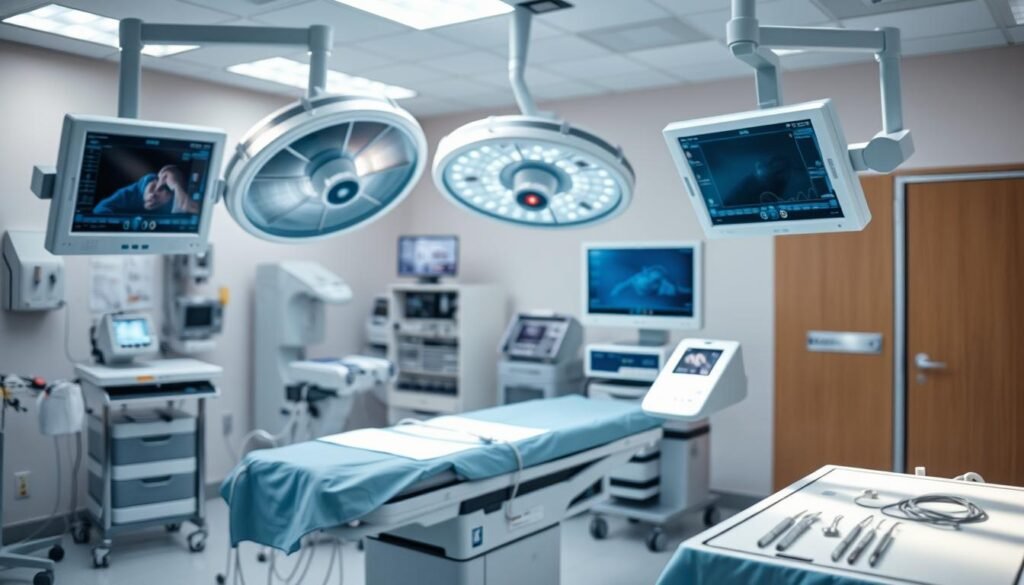About 80% of folks with early-stage non-small cell lung cancer can consider surgery. This fact places surgery at the center of offering hope for a cure. It’s key for patients to know their surgical choices, like thoracotomy and less invasive methods.
Seeing surgery as a key part of lung cancer care is important. Options like VATS and RATS are getting more common. They offer quicker recovery and less pain. Yet, everyone’s path is different. Discussing with doctors can ease worries about the process.
Getting ready for lung cancer surgery involves understanding the whole journey—from start to finish. This piece aims to cover all aspects of the surgery. It will give crucial details to help patients and their families feel empowered.
Key Takeaways
- Surgery for lung cancer is crucial for early-stage NSCLC patients, offering significant cure potential.
- Types of lung cancer surgery include thoracotomy and minimally invasive options like VATS and RATS.
- Minimally invasive surgeries generally lead to shorter hospital stays and quicker recovery.
- Postoperative care may involve physical therapy and lung function therapy for optimal recovery.
- Understanding the risks and benefits of each surgical option is essential for informed decision-making.
Understanding Lung Cancer and Surgical Options
Lung cancer causes major concern around the world. In 2018, about 2.09 million cases were reported. It mainly comes in two types: non-small cell lung cancer (NSCLC) and small cell lung cancer. NSCLC is the more common type. For those caught early, surgery is a key treatment option.
NSCLC patients may have surgery as their best chance for a cure. Lung resections are common surgeries. They remove all or part of a lung affected by cancer. Whether to have surgery depends on many factors. These include lung function and how far the cancer has spread. Doctors use tests and imaging to see if surgery is possible.
In 2018, 70% of lung cancer was found late. This led to a low survival rate of 19% in the U.S. Early detection and treatments like surgery are crucial. Screening programs can lower death rates by up to 24%. New surgical methods, like VATS and RATS, help lower risks. They shorten hospital stays and speed up recovery.
Types of Lung Cancer Surgery
Surgery is crucial in lung cancer treatment, with options based on each patient’s needs. The surgery chosen affects recovery, pain, and how well the treatment works. Let’s look at the two main lung cancer surgeries.
Open Lung Surgery (Thoracotomy)
Open lung surgery, or thoracotomy, means making a big cut in the chest. It’s used for big tumors or complex cases needing a close look and removal. Procedures include lobectomy, pneumonectomy, and wedge resection, each helping in different ways.
Lobectomy is the main lung cancer surgery. Pneumonectomy takes out the whole lung when the tumor is in the center. But, thoracotomy can lead to longer recovery and more pain afterwards.
Minimally Invasive Surgery: VATS and RATS
Techniques like Video-Assisted Thoracoscopic Surgery (VATS) and Robotic-Assisted Thoracoscopic Surgery (RATS) have changed lung surgery. They use smaller cuts, so recovery is quicker and less painful compared to open surgery. These methods offer precise operations.
VATS works well for specific procedures, chosen for those with weak lungs or small, early-stage tumors. The move to minimally invasive surgery focuses on the patient. For surgery details, check this resource.

Surgery for Lung Cancer: What to Expect Before the Procedure
Getting ready for lung cancer surgery is a multi-step process. It makes sure the patient is physically and mentally prepared. Tests before the surgery are very important. They check health conditions to plan the right surgical method.
Preoperative Tests and Assessments
In the week before the surgery, patients go through a lot of checks. These include:
| Test | Purpose |
|---|---|
| Blood Tests | To evaluate general health and kidney function |
| Swab Tests | To rule out infections |
| ECGs | To check heart health |
| Lung Function Tests | To assess lung capability |
| Echocardiograms | To visualize heart function |
| Chest X-rays | To examine lung condition |
| Cardiopulmonary Exercise Tests | To gauge overall physical fitness |
These pre-op steps are key for a safe recovery from lung cancer surgery. They help lower the risks of anesthesia and surgery.
Preparing for Surgery: Lifestyle Changes
Changing your lifestyle can really help your recovery. Patients should stop smoking at least a month before the surgery. Not smoking decreases complications and aids in a better recovery. Eating right and staying active also prepare you for recovery.
It’s good to sort out things like work leave, caring for others, and housework before going to the hospital. Packing a bag with personal stuff, meds, and things to do will make your two-day hospital stay nicer.
Having people to support you is very important. Friends or family can help with rides and everyday things while you recover. For more info on what to expect, check out this guide.

During the Surgery: The Process Explained
Surgery for lung cancer includes critical steps, like using anesthesia and different surgical methods. Knowing these can help understand what happens during surgery.
Anesthesia and Incision Techniques
Before surgery starts, using the right anesthesia is key for patient comfort. Doctors use general anesthesia to put the patient in a deep sleep during surgery. This keeps the patient relaxed and pain-free.
The way doctors make the incision depends on the surgery type. A thoracotomy makes a big cut in the chest to reach the lungs. On the other hand, VATS involves smaller cuts for less impact. The choice depends on the tumor’s size, place, and spread.
The Role of Robotic Assistance in Surgery
Robotic surgery has changed how doctors operate on lung cancer. It lets doctors use very precise tools through small cuts. This approach helps patients recover faster and feel less pain after surgery.
Robotic systems give doctors better control and view during surgery. This makes operating on complex parts easier. Patients tend to spend less time in the hospital and get back to normal life quicker.

| Type of Surgery | Incision Size | Recovery Time |
|---|---|---|
| Thoracotomy | Large | 6-8 weeks |
| VATS | Small | 1-3 weeks |
| Robotic-assisted | Very small | 1-2 weeks |
Lastly, lung cancer surgery involves detailed planning with anesthesia and different surgical options. Understanding these can lessen worries for patients about to undergo surgery.
Recovery After Lung Cancer Surgery
Recovery from lung cancer surgery is a journey that focuses on making patients comfortable and ensuring wellness. Care after the surgery helps patients move smoothly from the hospital to their home. Knowing what to expect helps patients tackle their recovery with confidence.
Postoperative Care and Hospital Stay
Patients are first taken to a recovery area and then to a hospital room after surgery. They receive pain management options, like medications and epidural blocks, to stay comfortable. The length of the hospital stay can vary from 2 to 7 days, based on the surgery.
- Monitoring of vital signs and recovery progress occurs closely.
- Patients often have tubes or drains, such as chest drains and urinary catheters, to manage fluid and pressure levels.
- Encouragement to sit in a chair within 12 hours post-op and walk the following day facilitates healing.
Effective communication with healthcare teams helps address any discomfort quickly. This ensures a better recovery experience from lung cancer surgery.
Long-term Recovery and Rehabilitation Strategies
Rehabilitation is key after leaving the hospital. It helps in regaining strength and improving lung function. A structured rehab program might include:
- Pulmonary rehabilitation exercises focused on enhancing lung capacity.
- Gradual reintroduction of daily activities, tailored according to individual capabilities.
- Regular follow-up appointments to monitor recovery and address any emerging issues.
Making lifestyle adjustments is part of long-term recovery. Joining a community or survivorship programs helps with emotional health. It’s important to keep open lines of communication, especially during follow-up visits to review progress and address symptoms.
Potential Risks and Complications of Lung Cancer Surgery
Lung cancer surgery can be a helpful treatment, but it’s important to know the risks. Understanding the risks of lung surgery helps in making an informed choice. Here are some common issues after the surgery:
- Feeling tired and weak
- Breathing difficulties and shortness of breath
- Pain, which may persist due to nerve damage
- Potential air leaks from the lung
- Infections affecting the wound, chest, or urinary tract
- Development of blood clots in the legs or lungs
- Excessive bleeding during or after surgery
Some lung cancer surgery complications are very serious. Blood clots, for example, can lead to pulmonary embolism. This condition shows up as chest pain, dizziness, and trouble breathing. Infections can cause symptoms like a high fever, constant coughing, and shivering.
After surgery, many patients feel weak and tired. Some may face long-term breathing difficulties, which impact their life and activities. For those who’ve had a pneumonectomy, swimming could be more challenging due to buoyancy issues. Good care after surgery is key to dealing with these problems and recovering well.
The Role of Lung Cancer Surgery Specialists
Choosing the right lung cancer surgery specialists is key to a patient’s treatment and recovery. It’s best to consider thoracic surgeons with deep expertise in lung cancer surgeries. A surgeon’s experience can greatly influence the surgery’s success and the patient’s chance of recovery.
Choosing the Right Surgeon for Your Needs
Patients looking for a thoracic surgeon should focus on those using the newest surgical methods. Techniques such as lobectomy, pneumonectomy, and video-assisted thoracic surgery (VATS) are impactful. They help save healthy lung tissue while removing tumors. It’s important for patients to check a surgeon’s history with lung cancer surgeries, paying attention to their success in procedures like wedge resection and thoracoscopy.
Importance of Experience in Thoracic Surgery
Statistics show that lung cancer surgeries, like lobectomies, have better outcomes with skilled specialists. Surgeries done by these experts often have higher five-year survival rates than average. This proves the value of a surgeon’s experience for the best results. Adding treatments like chemotherapy and radiation can also improve results, making it vital to carefully choose lung cancer surgery specialists. You can find more about surgical choices by visiting surgical treatment options.
Conclusion
Knowing about lung cancer surgery is vital for patients looking at treatment choices. Almost 234,580 new cases are expected in 2024, making it critical to make well-informed decisions. Being aware of surgical options like video-assisted surgery and open lobectomy is key. This helps in picking the best plan for treating non-small cell lung cancer. It’s important for patients to include lung cancer treatment insights in their care. This way, they can actively participate and strive for better outcomes with their healthcare team.
As surgical methods improve, the focus on care tailored to each person remains. This personalized care looks at the patient’s exact health and cancer stage. There are differences in who gets to live longer and who gets screened. This shows why talking with expert oncologists in lung cancer matters. Top oncologists have a big role in providing the right care. Working together with them ensures a well-managed treatment journey.
Lung cancer statistics are alarming, with someone diagnosed every two minutes. This shows how crucial early action and screenings are. Low-dose CT scans can greatly reduce death rates. They show the value of being proactive in healthcare for people at high risk. By being well-informed and pushing for the right screening and treatment, those with lung cancer can hope for a better path to recovery.